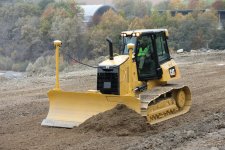Yes, I did actually! That makes more sense.
As for the bulldozer, it looks like a D5??? We got one that is two years old that is fitted with them as well. My Grandfather hates it as he I old school, but he can be like that sometimes. One day I watched him drive up across my field because I had water bars in the road, and he REFUSED "to pound over them." (They were not that bad).
Where exact GPS really helps is with reclamation. When I was out to the Black Thunder Mine in Wright, Wyoming, they said when they get done, if a rock was on top of the ground before they dig the coal out, when they are finally done with the area, the rock is put back in the same spot. All the same terrain, slopes, topography, etc. It is like they never dug the 120 feet of overburden out, and pulled the 90 feet deep of coal out of the ground.
